February – June 2008
- June 2008 Newsletter – June 8
- Other April News – Apr 6
- April 2008 Newsletter – Apr 2
- February 2008 Newsletter – Feb 1
June 2008 Newsletter
Shows and Exhibitions
- Dallas 2008
- What’s Hot In Tucson DVD and more…
Ten percent off your entire order for friends of Pala
Pala International News
Special Feature
- FotogFocus – Jeffrey Scovil: The Eye of a Curator
A look at the artist behind the camera
Shows and Exhibitions
Dallas 2008
Rough & Cut: Crystal and jewel…together at last
The gap between the gem and mineral world seems to be closing, as the agate lickers have evolved and the large corporate gem houses return to nature. Well, maybe not that extreme, but more awareness of gem materials has brought many stone collectors to delve into the source material and mineral collectors to have some appreciation for faceted stones. Finding beautiful and rare collectable pieces of nature is a endeavor at the heart of man.
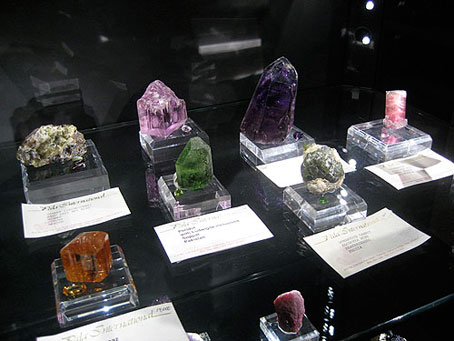 |
| Rough & Cut Display in Dallas. (left to right) Back: Mexican andradite garnet, Afghani kunzite, Mexican amethyst. Middle: Russian demantoid garnet, Californian pink tourmaline. Front: Brazilian imperial topaz, Pakistani peridot. (Photo: Jason Stephenson) |
The colored stone industry is far more evolved and commercialized as faceted gems find their way out of the jewelry store onto countless websites, or spinning around on late night television networks. A seemingly endless supply of goods—but in the words of the X Files, “the truth is out there.” If one chooses to collect gems and go down the rabbit hole of knowledge, there is much to be explored and inspired by.
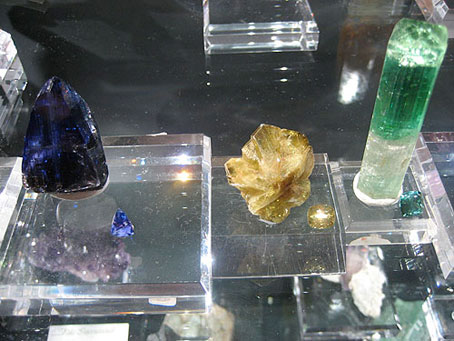 |
| Gem Crystals Indeed I: Tanzanian tanzanite with rich bluish-purple hue and some gemmy sections; Brazilian chrysoberyl with well-formed sixling; Afghani tourmaline in a large, cigar-sized crystal with bluish-green color. (Photo: Jason Stephenson) |
The mineral industry has mainly come limping out of the old mining localities around the U.S. A small group of geologists, explorers, and rock hounds has amassed collections that until recent times have been very esoteric. More recently there has been a quickening of new collectors onto the scene, driving prices skyward and exposing the true rarity and beauty of these specimens. A branching network of interested parties siphoning up the species that turn them on and turn them into the new layer of collectors.
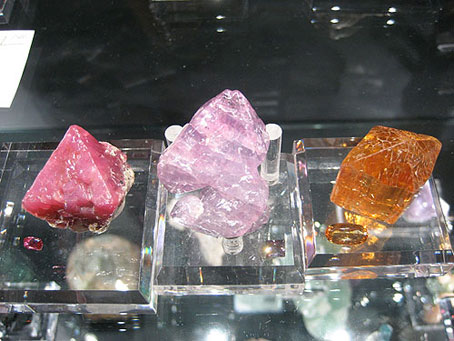 |
| Gem Crystals Indeed II: Tanzanian spinel in a strawberry-colored octahedron; an unusual Burmese lavender spinel; short and stocky Brazilian imperial topaz. (Photo: Jason Stephenson) |
As we join these two worlds we start to understand that gems are minerals in their purest form and actually start out in an assortment of shapes and sizes from unusual corners of our Earth. The ultimate in collecting is to display a well formed crystal with a representative sample of the same species in a faceted gem. To pair a rough-and-cut takes some strategy; from matching the pure color, to ideally having material from the same region within a single country.
Enjoy a few pictures from our display at the Dallas Fine Mineral Show earlier this month.
Crystals and gems and jewelry! Oh, my!
The Dallas show is mainly minerals, but gemstones are usually included to some degree. This year we expanded our display to include some cut stones paired up with their rough crystal counterparts, as well as introducing some high-end custom jewelry into the mix. Displaying these three stages of gem materials gained a lot of attention, as kids and adults alike were able to see the transformation from raw stone to a unique piece of jewelry.
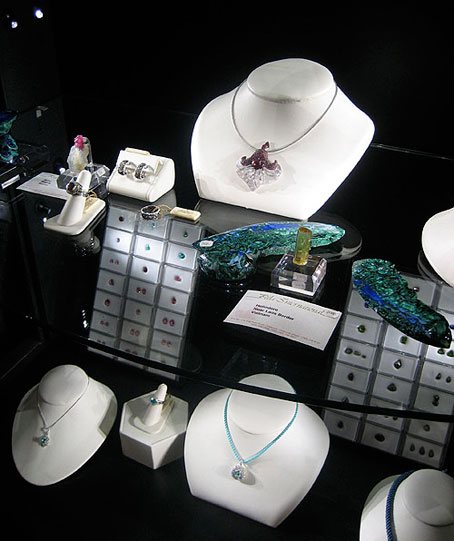 |
| Pala’s display showing the full spectrum from crystals to cut gemstones to jewelry. (Photo: Jason Stephenson) |
For example, we displayed some large pink tourmaline crystals from the Himalaya mine in San Diego, which were actually mined by Pala over the years. Some of this material was cut into beautiful pink gemstones that were also on display in an array of shapes and sizes. The story of pink tourmaline ended in a one-of-a-kind white gold ring, set with diamonds on the side of the band.
See these links for more images and video of Pala’s display in Dallas, courtesy The Vug:
- Close-up photos of Pala’s specimens
- A video tour of Pala’s display at the Dallas Show [back to top]
What’s Hot In Tucson DVD
Hosted by David Wilber
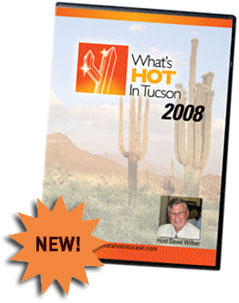 |
This two-DVD set includes these new features:
- Almost four hours of footage; see outtakes here
- “Collectors On The Street” segment
- “Scovil’s Top Ten Tucson Photos” segment
- Coverage of this year’s “American Mineral Treasures” exhibit
- An interview with Marshall Sussman, whose mineral collection from Tsumeb, Namibia, was on display
- Many behind-the-scenes segments that show mineral specimens you wouldn’t normally see there
- Hosted by long-time friend and mineral collecting pioneer David Wilber
Save Ten Percent on Your Entire Order
The producers of What’s Hot are offering friends and associates of Pala a ten percent discount on their entire catalog. Here’s how:
- Visit the Order DVD page
- Select Credit Card/PayPal payment method
- During checkout, enter the code palagems into the Coupon area (Note: The Coupon displays late in the ordering process, so be patient)
- Select the Apply Coupon button [back to top]
Other goodies from BlueCap Productions
These items also are available at the discount to friends of Pala:
- Rhodochrosites: Red Treasure of the Rockies – BlueCap is now distributing Silver Mountain Productions’ excellent, full-length film on the Sweet Home Mine rhodochrosites. This film was made in conjunction with Bryan Lees and features some fantastic interviews, underground footage, and computer animation to tell the entire story of the mine and the world-class rhodochrosites that came from that locale
- The Golden Age of Minerals – Now on DVD, this is the Sunday evening event at the 2004 Westward Look Mineral Show. Steve Smale leads a panel of some of the greatest mineral collectors in the world—including Pala’s Bill Larson. With a running time about 2 hours, this is longer than the 74-minute VHS version
And forthcoming (from the keyboard of Bryan Swoboda):
- We are currently finishing up our new film, A Women’s Perspective in Mineral Collecting, from the Sunday evening event at the 2008 Westward Look Mineral Show. Five notable women from the mineral collecting world (Gail Spann, Ann Frazier, Carolyn Manchester, Diane Brownlee, Dawn Minette, and Kerith Graeber) take the stage and talk about their experiences in this hobby that has long been viewed as a men’s-only hobby. Instead of just offering this for sale as a DVD, we are going to be posting this entire video online for free, with sections coming out on a weekly basis. We're doing this to help invigorate collecting among the young women who are interested in this hobby. The higher-quality DVD version, with the same footage, will also be made available for purchase
- In August we’ll be filming a special new program in which we’ll be taking a small group of young kids (all around 12 years old) to all the major pegmatite mines in the Pala area. This will include a visit to the world-famous Tourmaline Queen Mine, where they’ll be guided underground by Ed Swoboda as he shows them the location of the famous ’71 blue cap tourmaline pocket. The purpose of this film is to generate mineral collecting excitement among youth and to get the next generation involved in this great hobby. Expect a fall release for this program [back to top]
Pala International News
Pala’s Featured Mineral Specimens: Minerals of the Andes
Vivianite and Rhodochrosite
This month we feature some exceptional specimens from the central Andes Mountains in South America. The two mining regions highlighted are very remote and are found above 10,000 feet.
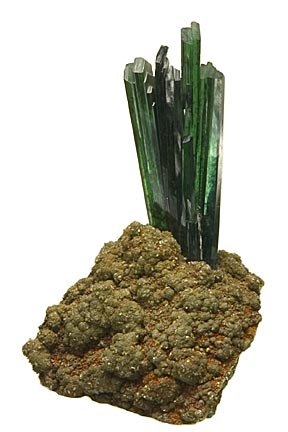 |
| Vivianite specimen, 10 x 6.6 x 5.5 cm. This specimen has been sold. (Photos: John Mclean) |
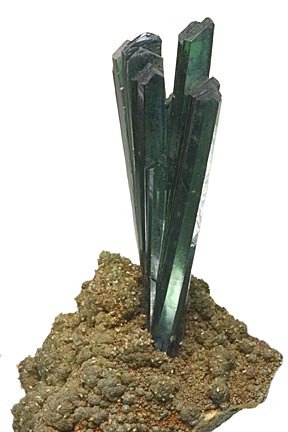 |
First, we have a striking cluster of vivianite crystals on matrix from the Potosí mining district in Bolivia. The long and slender acicular dark crystals form a small fan-like arrangement. Transmitted light reveals an intense evergreen hue in these clean, sharp crystals. The vivianite crystals lie on a botryoidal limonite matrix, and when the specimen is flipped over, a solid iron-pyrite core is revealed.The specimen comes from the Potosí deposit, which was one of the original sources for vivianite in Bolivia. Production from this deposit is very limited today, while most of the vivianite comes from other mines within the region. For more on vivianite, see Mindat.org.
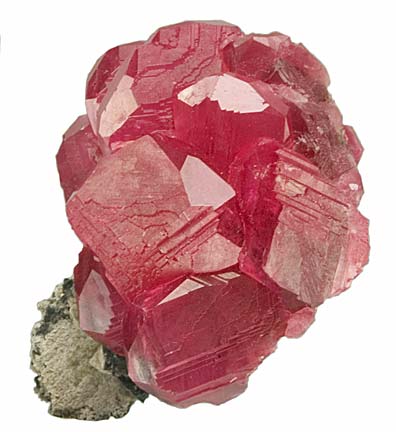 |
| Rhodocrosite specimen, 4.8 x 4.2 x 3.1 cm. Inventory #16371. (Photos: John Mclean) |
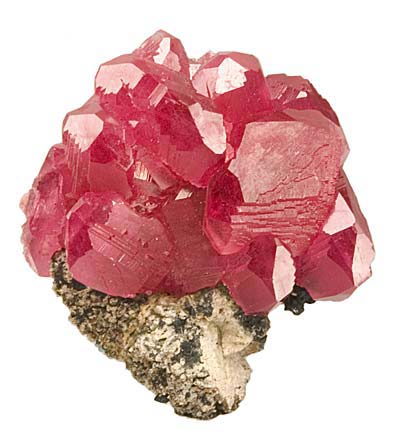 |
Our second featured mineral comes to us from the Pasto Bueno mining district in Peru. This rhodochrosite ball consists of intertwined scalenohedron crystals in a radiating-type fashion. This unusual golf ball-sized formation exhibits sharp, undamaged edges, lustrous faces, and some etched sections. This beautiful cluster of intensely-colored crystals glows with a neon pinkish-red hue, with transmitted light. The Pasto Bueno district is in the Pallasca province of Peru and actually includes seven different mines. Matching rhodochrosite specimens to the exact mine is a difficult task because of the array of crystal formations. Rhombohedral formation is the most common in this region, which makes this rhodochrosite specimen very unique. For more on rhodochrosite, see Mindat.org.
Interested? Select the inventory numbers above, email us, or give us a call. [back to top]
Special Feature
FotogFocus: Jeffrey Scovil – The Eye of a Curator
A look at the artist behind the camera
 |
Seasoned collectors and devotees of fine mineral specimens need little introduction to the photography of Jeffrey Scovil. If you’ve considered a photograph of your specimen, you've probably considered Jeff Scovil. If you’ve leafed through the pages of Rocks & Minerals or The Mineralogical Record—not to mention browsing Palagems.com—you’ve seen Jeff’s work.
But who knew that as a kid growing up in Westport, Connecticut, he assembeld what amounted to a natural science “museum” in his basement? Or that his academic degree is not in geology or photography, but in sociology and anthropology?
We feature Jeffrey Scovil as the second artist in our occasional series, FotogFocus.
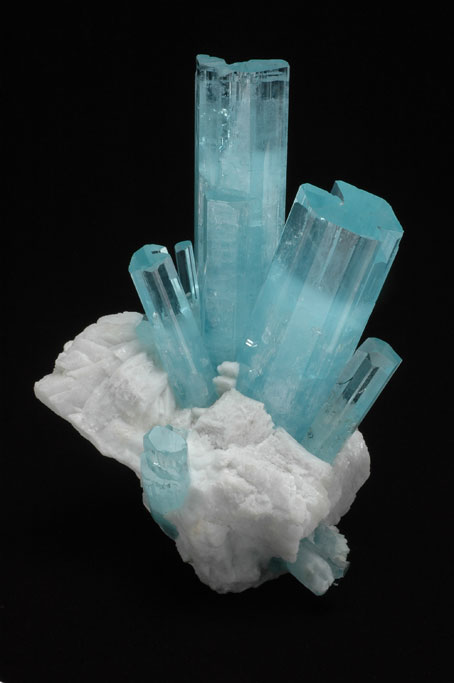 |
| Beryl var. aquamarine from Haramosh Mountains, Gilgit District, Northern Areas, Pakistan, 18.3 cm. high. Marc Weill Collection. See more work by Jeff Scovil here. (Photo © Jeffrey Scovil) |
Jeff’s top ten photos from this year’s Tucson show are available as prints from BlueCap Productions. [back to top]
— End June Newsletter • Published 6/8/08 —
Other April News
April 6: Tanzanite Foundation Establishes a Relief Fund
Flooding in Tanzanite Mining Area Due to
Torrential Rains in Tanzania, East Africa
The following message was received from the American Gem Trade Association regarding the tanzanite mine flooding we reported last week. It is a press release from the Tanzanite Foundation, which was established by TanzaniteOne, an operation in the area of the flooding.
2 April 2008
Merelani in Northern Tanzania has experienced severe rainfall over the last several days and as a result has caused flooding in the tanzanite mining area. This area is divided up into four blocks—A, B, C and D. TanzaniteOne operates Block C in world-leading safe and ethical mining conditions.
Indications to date are that six artisanal miners from neighboring mines have been confirmed dead with a further number reported missing. No employees of TanzaniteOne have been injured or trapped in these floods. TanzaniteOne is spearheading the flood relief rescue operation in conjunction with Barrick Africa and is assisting the government and the Tanzanians to rectify the situation.
The Tanzanite Foundation intends to raise funds to assist with post relief aid. To contribute to this worthy cause, please contact Hayley Henning at the Tanzanite Foundation New York at +1 212 575 3020 or hayley@tanzanitefoundation.org.
NOTES
Tanzanite is a rare and precious blue-violet gemstone found only at the foothills of the Majestic Mount Kilimanjaro in Tanzania, East Africa. 1,000 times more rare than a diamond, tanzanite is becoming one of the most sought after gemstones of modern times.
The Tanzanite Foundation is a non-profit, industry-supported organization that was established with the aim of placing social responsibility at the heart of all its industry practices, encouraging the development of a tanzanite industry free from exploitation, and ensuring that local Tanzanian communities share in the rewards that the tanzanite industry earns.
Hayley Henning
Tanzanite Foundation
T: 212 575 3020
Email: hayley@tanzanitefoundation.org
www.tanzanitefoundation.org
April 2008 Newsletter
Shows and Exhibitions
- Dallas Fine Mineral Show – May 2–4, 2008
- “Über-booth” at Tucson 2008
- West Coast Gem & Mineral Show – May 16–18, 2008
Pala International News
Mineral and Mineralogy News
Books
Shows and Exhibitions
2nd Annual Dallas Fine Mineral Show – May 2–4, 2008
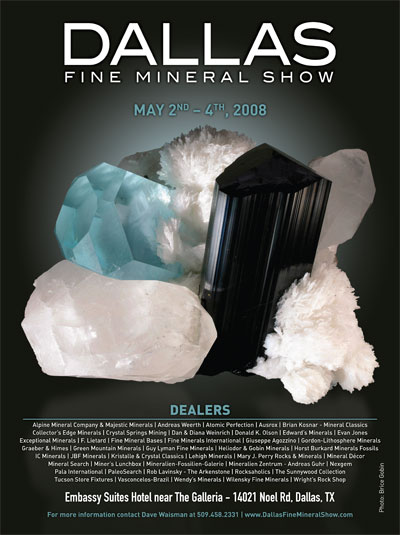 |
Visit Pala’s Roomful of Goodies (Suite 206)
 |
The 2nd Annual Dallas Fine Mineral Show is an exclusive show highlighting 48 top mineral dealers. Pala International will be exhibiting superb collections of minerals that Bill Larson has assembled over the years. Old classics and some new specimens from recent finds will be on display.
Event: Dallas Fine Mineral Show
When: May 2–4, 2008
Where: Embassy Suites Dallas
Suite: 206
We look forward to seeing our many friends there. Visit the Pala International Show Schedule for future events. [back to top]
“Über-booth” at Tucson 2008
Pala has combined forces with some of the top mineral dealers to create a new über-booth in Tucson. Pala International, Wayne Thompson, and The Arkenstone, of the U.S., combined with the always pleasant French dealers, the Gobin brothers and Alain Martaud.
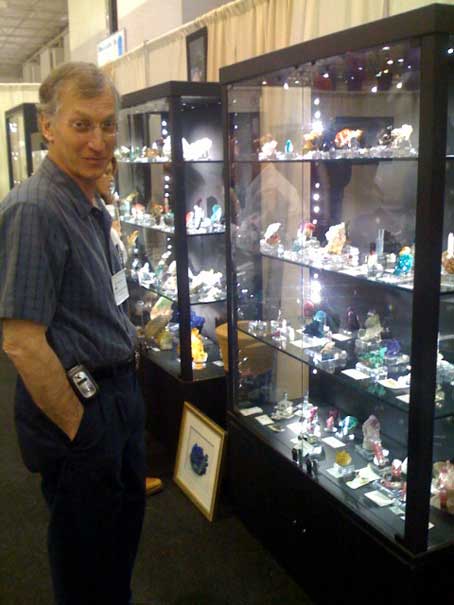 |
| Dave Waisman—producer of both the Westward Look and upcoming Dallas Fine Mineral shows—admiring some of Pala’s collection in the new booth. |
This year’s consortium created a new environment at the Tucson Gem and Mineral Show: sleek new black cases with fiber optic lighting, a lounge area, a bar table and chairs, full carpeting, and some bubbly refreshments. The booth seemed to be packed throughout the show with the all usual suspects—from the nation’s top museums to the young rock hounds to the well-known collectors from around the globe.
We’ll see you next year at the über-booth in Tucson, where the 2009 theme will be “Mineral Oddities.” [back to top]
West Coast Gem & Mineral Show – May 16–18, 2008
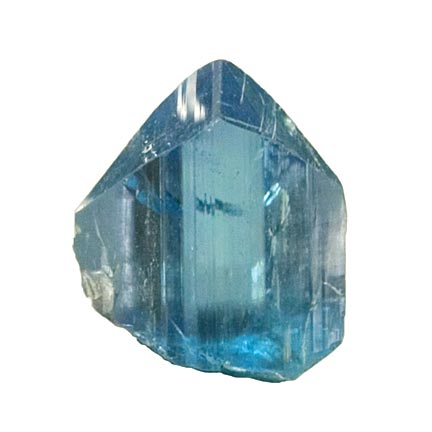 |
| Good cleavage…literally. Imagine stumbling upon such a specimen as this euclase crystal at a gem and mineral show. This particular crystal, from Chivor, Colombia, measures 1.4 x 1.3 x .8 cm. This specimen has been sold. (Photo: John McLean) |
Several members of the Pala staff will attend this show. See you there!
Event: West Coast Gem & Mineral Show
When: May 16–18, 2008
Where: Holiday Inn – Bristol Plaza, Costa Mesa, CA
[back to top]
Pala International News
Pala’s Featured Mineral Specimens: Amethyst
Amethyst is not just a pretty little faceted purple stone you see spinning around on the television gem shows. It actually has a quite unique array of crystal forms that are found on several continents. From Brazil and Uruguay, to India and Siberia, and even here in the U.S. from the state of Georgia. This month we feature two completely different forms of amethyst.
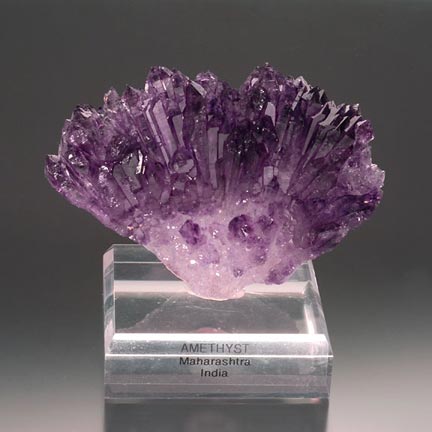 |
| Amethyst spray cluster, 11 x 8 x 2 cm. This specimen has been sold. (Photo: Wimon Manorotkul) |
This amethyst, from Maharashtra, India has an unusual radiating pattern that sprays out from the center to individual terminations. Slender amethyst crystals, like tightly packed rays of the sun, fan out in a beautiful arrangement. Pleasing to the eye and easy on the checkbook.
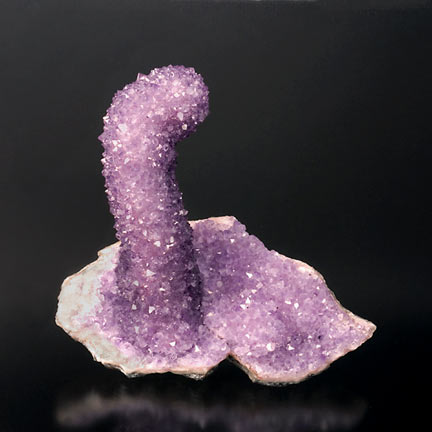 |
| Amethyst worm specimen, 11.5 x 11.5 x 5.4 cm. Inventory #16265. (Photo: Wimon Manorotkul) |
The second amethyst crystal comes to us from Artigas, Uruguay. This peculiar specimen features an overgrown druzy column that seems to be growing out of a geode-like base. Tiny amethyst crystals, densely packed, cover what was probably the inside of a vug. Then gravity or some internal force pushed a cylinder of amethyst melt into this worm-like form, ultimately being left to cool properly and giving rise to the network of sharp amethyst crystals.
Amethyst, in its many forms and memorable purple hue, is an obtainable mineral for the novice collector, but also very desirable for the veteran collector in search of the amethyst oddity.
Pala’s New Corundum Collection
Bill Larson’s hands-on approach in the mineral world has connected the dots between the actual mining endeavors on the one hand and, on the other, dealing with the collectors of the minerals found within the mines. Involved in mining operations around the globe, including Russia, Sri Lanka, Mexico, and right here in San Diego, Bill has seen firsthand what it takes to hunt and gather these often rare natural crystal forms.
 |
| Blue, yellow, and red corundum crystals exhibiting the classic tapering hexagonal dipyramidal form. Crystals are about 5 cm. tall; the blue and yellow sapphires are from Ratnapura, Sri Lanka, and the ruby is from Kitul, Kenya. (Photo: Jason Stephenson) |
Being able to discern a potential collector-specimen from a piece of rough for cutting takes not only a trained eye but also an artistic one: to imagine how best the crystal can be freed from its host or, even better, being able to keep a trace of the host as a base for a specimen. As a mineral collector, preserving nature’s crystal form is central, but to a gem lover the curiosity that goes along with the possibility of a clean, colorful stone being trapped inside the crystal is paramount. Witnessing the transformation from rough through cutting and the ultimate faceted gem is exciting and gratifying, if foresight and a little luck are on your side.
In his 40 years of globetrotting, Bill has mastered the art of assembling wonderful collections that represent either a single species found throughout the world, or one locality that produces a variety of species. These focused collections allow us to catalog the treasures of our planet in a calculated way while gaining knowledge of diagnostic crystallography from specific localities.
The new corundum collection contains representative samples from all major sapphire-producing regions. Studying this collection allows us to go back in time, leaving the seemingly endless assortment of faceted sapphires behind, and to understand the formation and ultimate crystal form that defines each of these sapphire-bearing deposits.
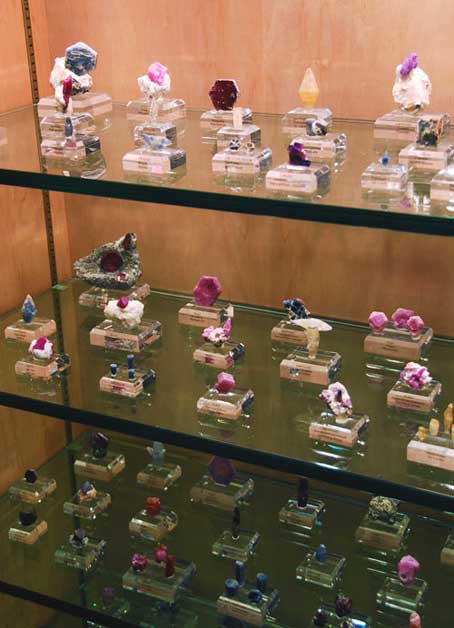 |
| The Corundum Collection is a new installation at Pala, and will be available for purchase once all the specimens are in place. (Photo: Jason Stephenson) |
The collection highlights some of the more well-known deposits of India, Sri Lanka, Myanmar, Vietnam, Madagascar, Tanzania, and some of the lesser-known ones: Russia, Australia, Brazil, Pakistan, Afghanistan, Macedonia, and the U.S., which all produce some form of corundum.
This collection is now on display in the mineral house on the Pala International grounds.
Interested in a single ruby or sapphire crystal? Check the following links to see what’s in stock:
[back to top]
Mineral and Mineralogy News
Miners Trapped, Killed in Tanzania
Tanzanite (aka zoisite) comes in a variety of hues, some rarer than others—from a deep indigo to a yellow-green to an almost colorless. The material is mined exclusively in Merelani, Arusha, in northeastern Tanzania.
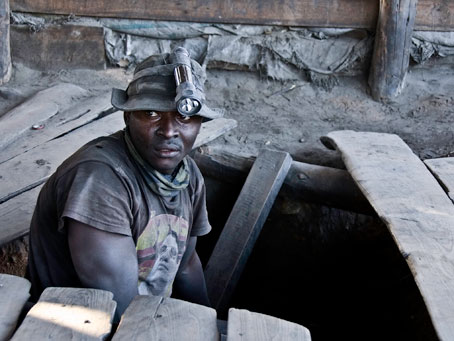 |
| A graphite-coated miner emerges from a tanzanite mine at Merelani’s Block D. Due to the desperate poverty endemic in Tanzania (and so many third-world countries), miners often work under unsafe conditions. The situation is not unique to the mining sector, but cuts across all sectors of the Tanzanian economy. Such conditions are not unlike coal mines in the U.K. and the U.S. in the 19th century. (Photo: Richard W. Hughes) |
This past weekend, miners at a tanzanite mine in Merelani were trapped and killed following seven days of heavy rain. The number of miners who managed to escape is disputed, but as of Monday, 66 were unaccounted for, according to the mine owners, as related by Agence France-Presse (AFP). The AFP article states that thousands of miners work in the area.
 |
| This stunning zoisite crystal was our featured mineral specimen in December 2006. Such material is rarely seen in a yellow-green hue. (Photo: Wimon Manorotkul) |
While dramatic incidents like the present one in Merelani fortunately are not common in countries of the global south, the life of a miner is not easy. (Even in the U.S., coal mining continues to be one of a dozen relatively hazardous occupations.) Mining safety usually is balanced against other issues, such as attraction of foreign investment and the real need of workers for employment. Entrepreneurship is capable, however, of a measured and humane approach, as demonstrated by mining operator Moussa Konate in Mozambique (see our February Gem News report), who appears to be placing sustainability before swift gain. Thus the good, the bad, and the ugly are some of the strands in the backdrop behind what takes center stage: beautiful and exciting minerals and gemstones.
For more on the story of the Merelani mines, see our reprint from Peter Bancroft’s Gem and Crystal Treasures. [back to top]
Books
American Mineral Treasures
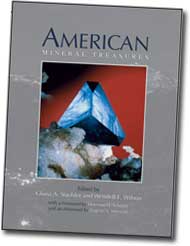 |
The theme of the 54th Annual Tucson Gem and Mineral Show was “Minerals of the USA,” highlighting all the great mining localities that brought beautiful and fascinating specimens for the world to see. American Mineral Treasures, edited by Gloria A. Staebler and Wendell E. Wilson, was inspired by this year’s show.
This hardbound 350-page beauty is the most comprehensive book compiled on American minerals, mining localities, and the great folklore that goes along with discovery and exploration.
The introduction, on a brief history of mineral collecting, sets the stage and outlines collectors, starting in the early 1600s and continuing through today’s prominent collectors/dealers.
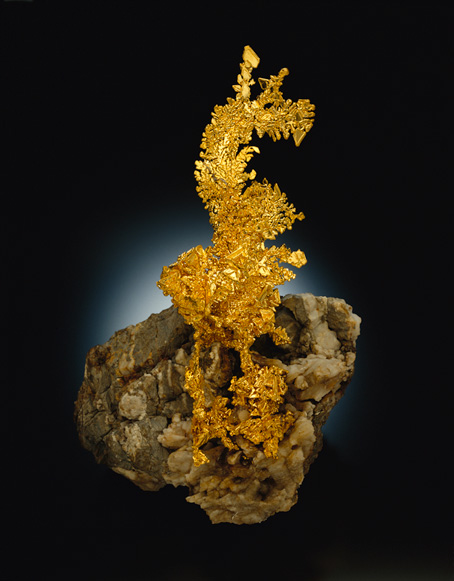 |
| “The Dragon” is an 18-cm. tall crystallized gold cluster on matrix from the Colorado Quartz mine in Mariposa County, California. This specimen was discovered in 1998 and now resides at the Houston Museum of Natural Sciences. American Mineral Treasures, p. 20. (Photo © Jeffrey Scovil) |
The chapters bounce around the country like an enthusiastic collector seeking knowledge about the variety of deposits—from the remote epidote deposits in Alaska to the unusual zinc ore minerals of New Jersey, from the spectacular pegmatite minerals of San Diego County to the high-elevation aquamarine and rhodochrosite deposits of Colorado. From the shocking pyromorphite specimens of Idaho to the stunning crystallized gold from the foothills of the Sierra Nevadas. A total of 44 mineral-producing areas are highlighted in glorious detail.
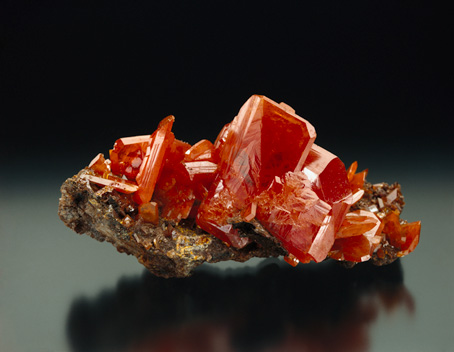 |
| “Wulfenite is Love,” a beautiful bladey wulfenite specimen from the Red Cloud mine in La Paz, Arizona. This specimen was discovered by Wayne Thompson’s efforts at the mine in 1996. American Mineral Treasures, p. 65 (Photo © Jeffrey Scovil) |
All the chapters were written by the individuals actually involved with the mining efforts, which gives the stories a real, raw sense of what it was like. Each chapter takes you through the history of the mining area and all the charters driven by “gold fever” to find what lay behind the rock wall.
These colorful stories of adventure and exploration are complemented by splendid photographs of some of the best and/or quintessential pieces found. A must-have encyclopedia of USA minerals for the collector.
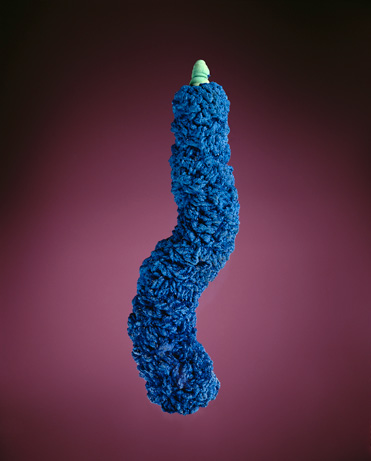 |
| Azurite and malachite stalactite from the Morenci Mine in Greenlee County, Arizona. The mineral oddity now resides in the Les and Paula Presmyk collection. American Mineral Treasures, p. 142. (Photo © Jeffrey Scovil) |
The book is available from the publisher. See the table of contents. [back to top]
— End April Newsletter • Published 4/2/08 —
February 2008 Newsletter
Shows and Exhibitions
Pala International News
Minerals and Mineralogy News
- Pala District Pegmatite Opens Wider
- All Things Fluorite
- Another Green World
White and “green-spotted” jade from Ge’ermu
Special Feature
- FotogFocus – The work of Bruno Cupillard
A look at the artists behind the camera
Shows and Exhibitions
Tucson Time – February 6–17, 2008
We’re packing our bags for the world’s greatest gem and mineral show in February.
 |
See Pala International’s page on the Westward Look Show site.
Pala International will be represented in Tucson as follows.
Event: AGTA GemFair
When: February 6–11, 2008
Where: Tucson Convention Center
Booth: 1016–1018
Event: Westward Look Mineral Show
When: February 8–11, 2008
Where: Westward Look Resort
Suite: 236
Website: Official show website
Event: 54th Annual Tucson Gem and Mineral Show
When: February 14–17, 2008
Where: Tucson Convention Center
Booth: Aisle 5 East
We look forward to seeing our many friends there. Visit the Pala International Show Schedule for future events. [back to top]
Tucson Traffic Tips
Rebecca Lobo Picon, a Tucson realtor—who tells us her mother visits the gem and mineral show with a rolling suitcase for her purchases—sent us these helpful tips regarding the construction of Interstate 10. (Both in PDF)
[back to top]
Pala International News
Pala’s Featured Mineral Specimens: Pink Tourmaline and Diopside
This month we couldn’t help but feature two minerals—one to stay on topic with this year’s Tucson theme of Minerals of the USA, and another to show off our new glowing neon-green crystal from Tanzania.
 |
| Pink tourmaline. The larger crystal measures 6.2 x 2.5 cm.; the smaller crystal measures 3.3 cm. This specimen has been sold. (Photo: Wimon Manorotkul) |
This beautifully crystalline and glassy pink tourmaline specimen was dug by Pala International during our 20-year mining efforts at the Himalaya mine here in San Diego County. The mine produced all shapes, sizes, and colors of tourmalines, but this one seems to have some extra intrinsic beauty. It’s composed of two interlocking pink transparent crystals of tourmaline with some lepidolite sprinkled on top. One exceptional 9-mm. lavender lepidolite crystal is positioned right at the tourmaline junction and sits on a plate of white clevelandite.
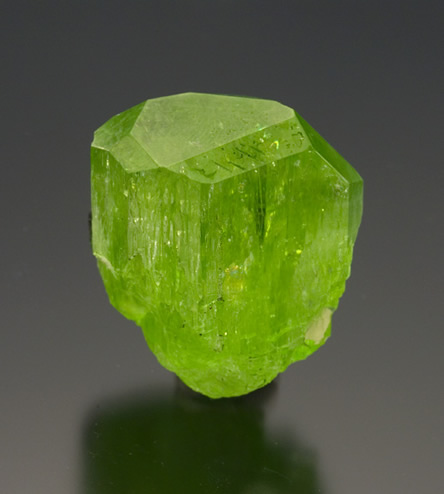 |
| Diopside from Tanzania. This specimen measures 3 x 2.5 x 2.5 cm. This specimen has been sold. (Photo: Wimon Manorotkul) |
This shocking diopside crystal seems to take on a neon glow of yellowish green. The crystal is a bit beat-up on the bottom but shows a short shiny shaft and is topped off by a glassy complex termination with windows into the heart of the gem. This diopside crystal is from the Arusha region of Tanzania where the massive tanzanite deposits lay. In rare cases tanzanite and diopside can be found on the same specimen as exhibited by Inventory #16009. [back to top]
Minerals and Mineralogy News
Pala District Pegmatite Opens Wider
Oceanview Mine Strikes It Big
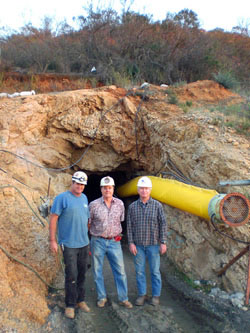 |
| Jeff Swanger, Bill Larson, and John McLean preparing to go underground. (Photo: Jason Stephenson) |
The new year brings new gems to the surface. The Pala Mining District pegmatite opens wider. (See more on this recent find in December’s Mineral News.)
With the 49er pocket continuing to show its girth, members of the Pala crew—including Bill Larson, John McLean, and Jason Stephenson—were invited up to the Oceanview Mine on December 14, 2007, to see the progression first-hand and get their hands dirty. Owner Jeff Swanger, being a true miner and rock hunter, knew we wanted to get a taste of excavating some of the lustrous beryls that have been bubbling out of the pocket. Jeff set us up with hard hats, lights, a pneumatic chisel, crowbars, screw drivers, and kabob sticks for exposing the delicate crystal clusters.
Jeff and his crew have been excavating the 49er pocket since its discovery on September 22 of 2007—moving rock and cleaning hundreds of specimens from large euhedral feldspar crystals, gigantic quartz clusters, schorl crystals, and beryl specimens. Peter Renwick was there this time making runs in and out of the mine with the bobcat, transporting the clay-laden specimens to their cleaning baths.
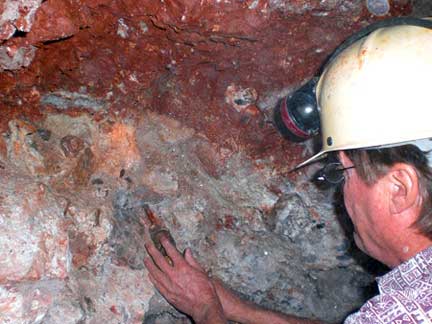 |
| Bill Larson in action. A legend in the gem mining community, back to his roots. (Photo: Jason Stephenson) |
The new face of the 49er pocket had been recently cleaned up with a few precise explosions to expose the mineral-rich area that encircled a solid clevelandite plate. Most of the pristine specimens had been drawn from around this section, and a dozen beryl faces were already shining and waiting to be plucked from their host (pictured above). Bill immediately went to work with the mini-jack and crowbar, carefully removing rock sections that would relieve pressure on the small sections that had potential to yield the finest matrix specimens.
Like a sculptor freeing the figure from within solid stone, the Pala crew wrestled with the stubborn rock and luckily removed all the major pieces without any damage. Extracting the largest chunks possible was the technique, since they could always be trimmed down later. Three hours later we had removed several buckets full of promising looking specimens; some took two of us to haul down to the bobcat. Emotions were high and everyone was buzzing with excitement at this unique experience—especially Jeff and crew who had persevered though seven years and over 400 feet of mostly barren rock.
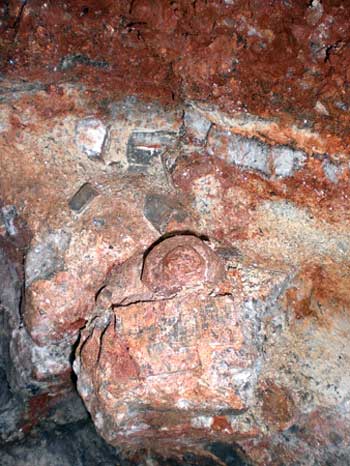 |
| Gem pocket indeed. A close-up view of the mineralized zone. Notice the white clevelandite plate running horizontally in the upper-middle of the photo; clay above and several beryl crystals below. (Photo: Jason Stephenson) |
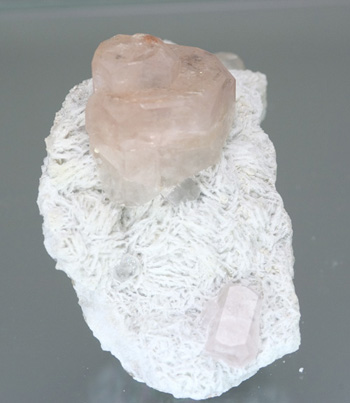 |
| Morganite on clevelandite. This beautiful morganite crystal measures 6 cm. on a bright white bed of clevelandite. (Photo: Jason Stephenson) |
Above you can see the before-and-after of “the nipple,” a unique morganite crystal that seemed to be the center of attention on the new surface of the pocket. The pocket is estimated to be twelve feet long so far and has fluctuated in width from a couple of feet to eight feet at the present. The amazing thing is that the 49er pockets still show promising signs of continuing into the mountain. Hopefully we will be seeing more beautiful beryl specimens in the near future.
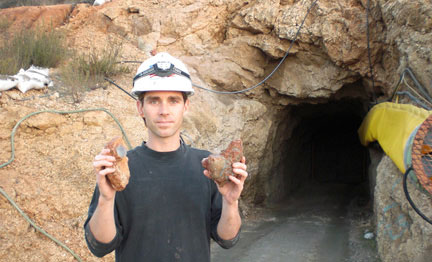 |
| The miners emerge. Jason Stephenson holds the day’s freshly dug treasures in the light of day. (Photo: Bill Larson) |
The job had just begun, on the other side, to trim and beautify the specimens. Bill and John have a few decades under their belt when it comes to this esoteric art. Bill started right in on the first piece using the saw to trim away the excess matrix, accentuating the full form of the crystal. Pala has become the chosen agent to prepare these specimens for display and was given the rights to sell 19 choice pieces. We will be displaying the new specimens in Tucson next month.
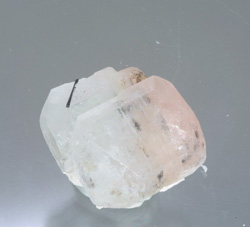 |
| Bi-color beryl. Half aquamarine, half morganite, this beautifully colored crystal is doubly terminated with some schorl inclusions. (Photo: Jason Stephenson) |
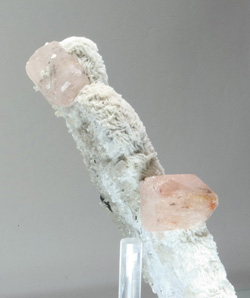 |
| Unusual beryl combo. With two colors of morganite on the same thick plate of clevelandite, this specimen also contain an aquamarine crystal. (Photo: Jason Stephenson) |
Jeff’s hospitality and graciousness made the trip very fun and comfortable. Jeff loves to share his mining experience and even runs group tours every Sunday on location at the Oceanview Mine. The Oceanview is the only mine that carries permits to actually bring the public underground. The operations also have a screening area where the visitors can try their luck in the tailings, which now definitely have some hidden jewels to be found.
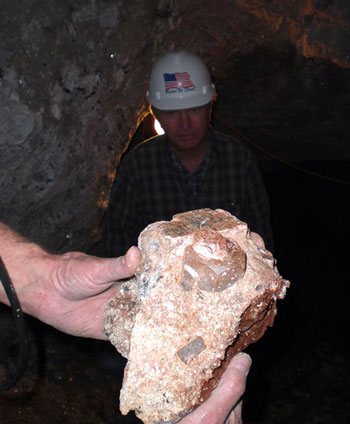 |
| Man and rock. Even John McLean was showing his enthusiasm on the dig. (Photo: Jason Stephenson) |
Another interesting aspect of the beryls being removed from the 49er pocket is the assortment of inclusions being found locked inside the crystals. Many microscopic two-phase inclusions can be seen as well as eye-visible bubbles that move as you rotate the crystal. A few dendrites were found in the formation of branching trees. Also a variety of single-crystal inclusions of quartz, feldspars, and some unidentified pink inclusions.
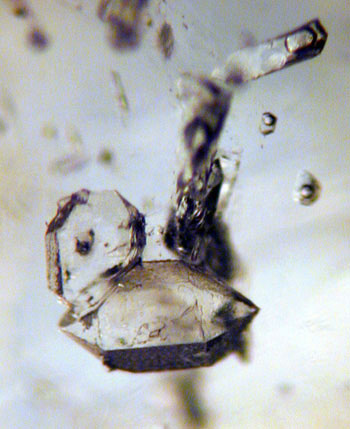 |
| Euhedral quartz crystals in a Japan-law twin-like formation, suggest syngenetic formation with the beryl host. Also notice the two-phase inclusions. (Photo: Jason Stephenson) |
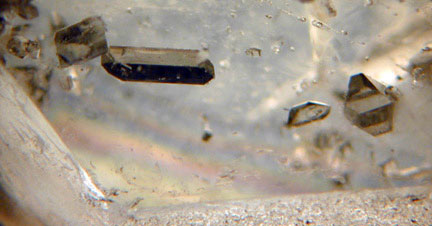 |
| Confetti of single-crystal inclusions, most likely quartz and feldspar, with some small two-phase inclusions. This material also produced some bubbles trapped within negative crystals. (Photo: Jason Stephenson) |
Along with all the beryls, a few nice large quartz crystals and clusters were hauled out, some weighing hundreds of pounds. A lot of the material is facetable grade citrine and smoky varieties. See the next generation enjoying the fruits of the Larson lineage, below.
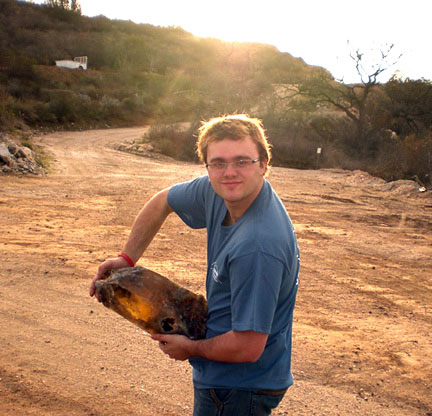 |
| The catch of the day. Will Larson showing off a large citrine crystal. (Photo: Bill Larson) |
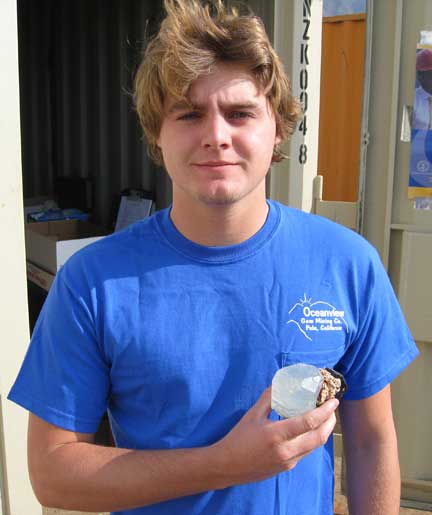 |
| I pledge allegiance to the “Prince.” Carl Larson holding the finest aquamarine specimen, named “The Prince,” dug from the 49er pocket. Wearing his new Oceanview gem mine T-shirt. (Photo Bill Larson) |
Information on gem tours and digging available through the The Oceanview Gem Mine. [back to top]
All Things Fluorite
French website devoted to “spathfluor”
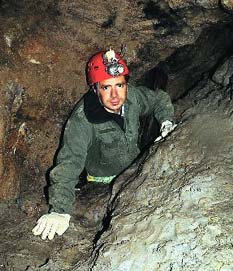 |
Pala International recently was asked to contribute a photograph to a website devoted to fluorite—in all its variations. Spathfluor.com, named after the French word for fluorspar, is the website of author and collector Etienne Guillou-Gotkovsky (pictured at right).
The website has brief descriptions of several French fluorite mines as well as a profile of collector Gilles Emringer. Also featured are notes for new collectors and “traps to be avoided.”
The website is filled with photographs and includes an overview of Guillou-Gotkovsky’s book, La Mine de Fluorine de Valzergues (1999), about the famous mine in southern France (see review here). An “extended version” of the website is available for “scientists or mineralogists seeking more information.”
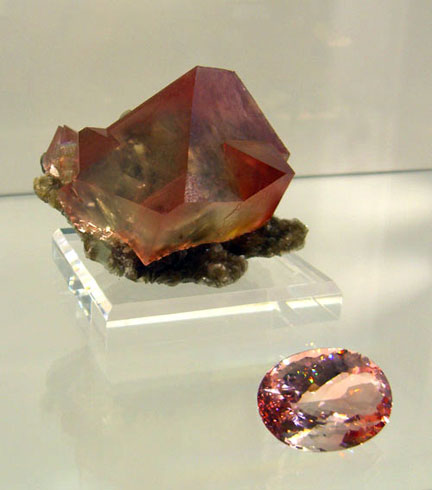 |
| At the Munich show. This photo, from last fall’s Mineralientage München, is “on loan” at Spathfluor.com. (Photo: Bill Larson) |
[back to top]
Another Green World
White and “green-spotted” jade from Ge’ermu
Last month, in our sister publication, Gem News, we included an item about white jade from the Chinese province of Qinghai, which will be incorporated into Olympic medals for the 2008 games in Beijing.
Last fall, Friends of Jade published a series of pieces by Herbert Giess on white nephrite jade from Ge’ermu, the locality in Qinghai. We provide here a few photos, courtesy of Friends of Jade, to tease you into reading about this white and “green-spotted” material.
- The Greens are coming: White nephrite jade from Ge’ermu with green spots
- A mountain scene carved in white jade from Ge’ermu
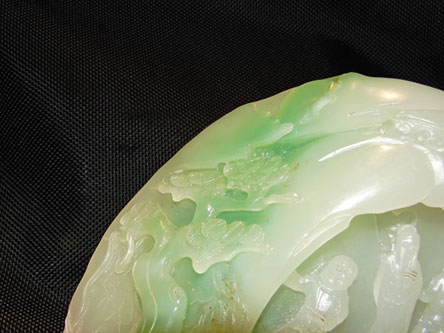 |
| Detail of jade mountain carving (above) shows a green streak that was thought possibly to have been stained by its carver. A cut section of rough (below), typical of Ge’ermu white jade, convinced Herbert Giess that the color is a naturally occurring phenomenon. More photos here. (Photos © Herbert Giess, Friends of Jade) |
 |
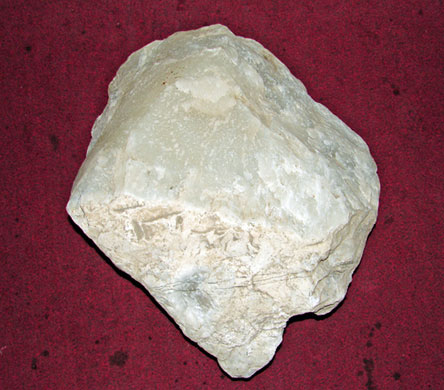 |
| Before: A 5-kg. rough, obtained by Giess in 2005. Note the opaque portions at the bottom corner. After: The work of master carver Ma Qing Hua depicts a sage playing a Chinese zither beneath a pine tree, with stair steps leading to the mouth of a cave. Less than a kilogram was lost in the carving. And, of course, you'll be wanting to see the reverse side. (Photos © Herbert Giess, Friends of Jade) |
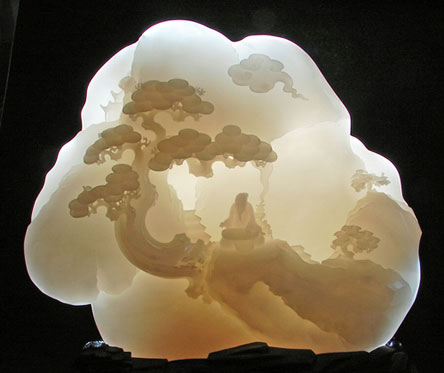 |
[back to top]
Special Feature
FotogFocus: A look at the artists behind the camera
Last year’s “Flashes of Colour: Legendary Wines and Gemstones” exhibition featured the work of French photographer Bruno Cupillard. We were so taken by his work that we wondered what it would be like to look behind the camera at Cupillard and other mineral and gemstone photographers.
FotogFocus will be an occasional peek at the “photogs” whose work we’ve come to love, with a single page on Palagems.com dedicated to each of them.
Bruno Cupillard: Aventures Cristallines
Bruno Cupillard sees his work as an adventure—an entry into “a world where our reference marks are confounded.” A collector of “stones” in the Jura (on France’s eastern border) with an interest in gemology, Cupillard was lured beyond mere identification of what he found.
…I quickly understood that the suggestive interpretation of the graphs drawn by nature is the engine of the most surprising voyages. I wondered since many years about what is hidden inside the stones, like others could explore the sea-bed.
I started to select stones which spoke of landscapes, then studied those whose color and transparency allowed them to be cut.
I had discovered gems!
Read more about Bruno Cupillard and see more photos on Palagems.com.
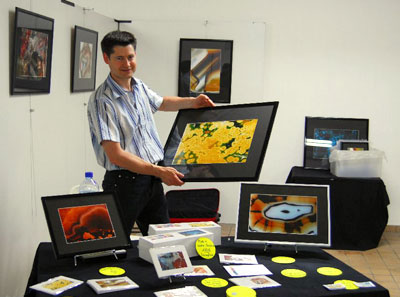 |
Bruno Cupillard’s work is available in several formats from his website: Aventures Cristallines.
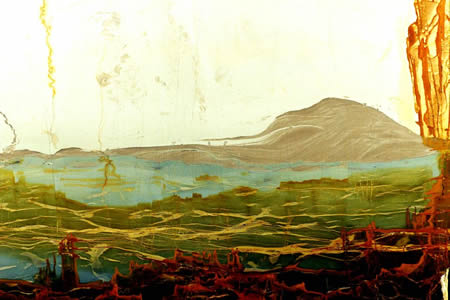 |
| Vesuvio. One of Cupillard’s “landscapes,” the source here is paesine, or limestone that has split and shifted. (Photo © Bruno Cupillard) |
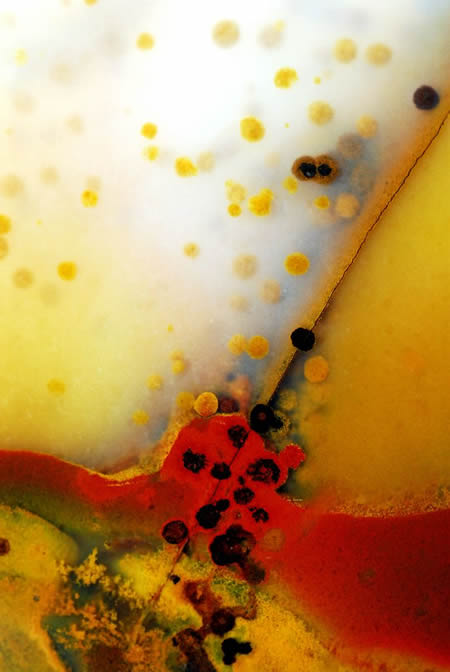 |
| Polka. Like some recently unearthed (ouch!) Kandinsky, Cupillard achieves a balance of movement and stasis in this image of agate. (Photo © Bruno Cupillard) |
[back to top]
— End February Newsletter • Published 2/1/08 —